(这部分代码如果对你有帮助,下面这个最新的链接,说不定你更需要:【深度学习数据增强处理】imgaug Augment Polygons 对标注图片和polygons的数据增强)
后面的所有变换,均以此为原图:

一、改变尺寸resize
import math
import random
import torch
from PIL import Image, ImageDraw
import torchvision.transforms.functional as F
def resize(img, boxes, size, max_size=1000):
w, h = img.size #(800, 600)
print('wwww',w)
print('hhhh',h)
if isinstance(size, int): #这里是按照高和宽等比例缩放,短边缩放
print('is============')
size_min = min(w, h) #这里我以输入300为例
size_max = max(w, h) #首先找到最小额一边,缩放的边是600
# 等比例缩放
sw = sh = float(size) / size_min #计算出高缩放的比例,将宽缩放到同等比例:300.0/600=0.5
print('sw', sw)
print('sh', sh)
if sw * size_max > max_size: #放置缩放过大:0.5*800=400>1000 false
sw = sh = float(max_size) / size_max
print('ifl====',sw)
ow = int(w * sw + 0.5) # 取整,800*0.5+0.5=400
print('ow',ow)
oh = int(h * sh + 0.5) # 取整,600*0.5+0.5=300
print('oh',oh)
else:
print('else============') #这里输入的就是(300,300)
ow, oh = size
print('ow',ow)
print('oh',oh)
sw = float(ow) / w # 300.0/800=0.375
print('sw', sw)
sh = float(oh) / h # 300.0/600=0.5 计算高和框的缩放比例,boxes乘以这个比例即可
print('sh', sh)
print(boxes, [sw, sh, sw, sh])
print('boxes', boxes*torch.Tensor([sw, sh, sw, sh]))
# return img.resize((ow, oh), Image.BILINEAR), boxes*torch.Tensor([sw,sh,sw,sh]) # 方式一:Image.resize
return F.resize(img, (ow, oh)), boxes*torch.Tensor([sw,sh,sw,sh]) # 方式二:torchvision
def draw(img, boxes):
draw = ImageDraw.Draw(img)
for box in boxes:
draw.rectangle(list(box), outline='red')
img.show()
def test():
img = Image.open('F:\lingjun2019\Body_Recog\Data-Augment-master\data\image/01.jpg')
boxes = torch.Tensor([[96, 34, 504, 355]])
img_resized, boxes = resize(img, boxes, (300, 300))
print(img_resized.size)
draw(img_resized, boxes)
if __name__=='__main__':
test()
resize后的图像显示:
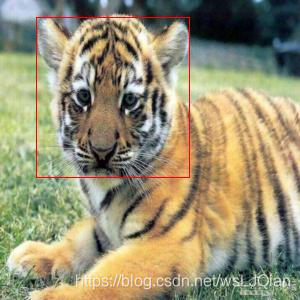
此外,上述简单代码参考了DETR官方案例:
1.这块参考这里:Deformable-DETR/transforms.py at main · fundamentalvision/Deformable-DETR · GitHub
2.https://github.com/facebookresearch/detectron2/blob/master/detectron2/data/transforms/transform.py
后续的内容也会以此作为参考,进行附录,希望能够对你的理解有帮助。当你有进一步的修改,比如分割时候,均能够有很好的借鉴。
import random
import torch
import torchvision
import torchvision.transforms.functional as F
def interpolate(input, size=None, scale_factor=None, mode="nearest", align_corners=None):
# type: (Tensor, Optional[List[int]], Optional[float], str, Optional[bool]) -> Tensor
"""
Equivalent to nn.functional.interpolate, but with support for empty batch sizes.
This will eventually be supported natively by PyTorch, and this
class can go away.
"""
if float(torchvision.__version__[:3]) < 0.7:
if input.numel() > 0:
return torch.nn.functional.interpolate(
input, size, scale_factor, mode, align_corners
)
output_shape = _output_size(2, input, size, scale_factor)
output_shape = list(input.shape[:-2]) + list(output_shape)
if float(torchvision.__version__[:3]) < 0.5:
return _NewEmptyTensorOp.apply(input, output_shape)
return _new_empty_tensor(input, output_shape)
else:
return torchvision.ops.misc.interpolate(input, size, scale_factor, mode, align_corners)
def resize(image, target, size, max_size=None):
# size can be min_size (scalar) or (w, h) tuple
def get_size_with_aspect_ratio(image_size, size, max_size=None):
w, h = image_size
if max_size is not None:
min_original_size = float(min((w, h)))
max_original_size = float(max((w, h)))
if max_original_size / min_original_size * size > max_size:
size = int(round(max_size * min_original_size / max_original_size))
# 有一个边,与resize后的边相同,直接返回原图大小
if (w <= h and w == size) or (h <= w and h == size):
return (h, w)
if w < h:
ow = size
oh = int(size * h / w)
else:
oh = size
ow = int(size * w / h)
return (oh, ow)
def get_size(image_size, size, max_size=None):
if isinstance(size, (list, tuple)):
return size[::-1]
else:
return get_size_with_aspect_ratio(image_size, size, max_size)
size = get_size(image.size, size, max_size)
rescaled_image = F.resize(image, size)
if target is None:
return rescaled_image, None
ratios = tuple(float(s) / float(s_orig) for s, s_orig in zip(rescaled_image.size, image.size))
ratio_width, ratio_height = ratios
target = target.copy()
if "boxes" in target:
boxes = target["boxes"]
scaled_boxes = boxes * torch.as_tensor([ratio_width, ratio_height, ratio_width, ratio_height])
target["boxes"] = scaled_boxes
if "area" in target:
area = target["area"]
scaled_area = area * (ratio_width * ratio_height)
target["area"] = scaled_area
h, w = size
target["size"] = torch.tensor([h, w])
if "masks" in target:
# 对target['masks']进行插值处理
target['masks'] = interpolate(
target['masks'][:, None].float(), size, mode="nearest")[:, 0] > 0.5
return rescaled_image, target
class RandomResize(object):
'''
T.RandomResize([600,800,1000], max_size=1333),
'''
def __init__(self, sizes, max_size=None):
assert isinstance(sizes, (list, tuple))
self.sizes = sizes
self.max_size = max_size
def __call__(self, img, target=None):
size = random.choice(self.sizes)
return resize(img, target, size, self.max_size)二、裁剪crop
裁剪这里主要就是看如何裁剪?也就是按什么方式进行裁剪。比如:
- 中心裁剪,以图像中心为基准,裁剪固定大小图像
- 随机图像大小裁剪,给定图像大小变换的范围,这样根据这个范围,去原图里面裁剪
- 随机裁剪,前两种尽管随机,但还都是有限制的,这种就是毫无约束
2.1 中心裁剪center_crop
import math
import random
import torch
from PIL import Image, ImageDraw
import torchvision.transforms.functional as F
def center_crop(img, boxes, size):
"""
1.计算定位到裁剪的区域坐标top, left, height, width
2.img.crop裁剪图像
3.原boxes-裁剪区域box,去除掉超出边界的像素块
:param img: 原图
:param boxes: 原图boxes坐标
:param size: 中心裁剪后的大小
:return:
"""
w, h = img.size
ow, oh = size
i = int(round((h - oh) / 2.)) #同样我们只需要将照片二边需要减掉的高和宽计算出来
print('i',i)
j = int(round((w - ow) / 2.))
print('j',j)
img = img.crop((j, i, j+ow, i+oh)) #利用自带的图像处理,选取图像固定位置:top, left, height, width
print(img.size)
print('bo', boxes)
boxes = boxes - torch.Tensor([j,i,j,i]) #将boxes减去就可以需要的boxes位置信息
print('boxes', boxes) # (x1,y1,x2,y2)
print(boxes[:, ::2])
boxes[:, ::2].clamp_(min=0, max=ow-1) # clamp函数是用来防止超出边界, boxes[:, ::2]=tensor([[-154., 254.]])
print('bo1', boxes)
boxes[:, 1::2].clamp_(min=0, max=oh-1)
print('bo2', boxes)
return img, boxes
def draw(img, boxes):
draw = ImageDraw.Draw(img)
for box in boxes:
draw.rectangle(list(box), outline='red')
img.show()
img.save('center_crop_300.jpg')
def test():
img = Image.open('F:\lingjun2019\Body_Recog\Data-Augment-master\data\image/01.jpg')
boxes = torch.Tensor([[96, 34, 504, 355]])
# img_resized, boxes = resize(img, boxes, (300, 300))
img_resized, boxes = center_crop(img, boxes, (300, 300))
print(img_resized.size)
draw(img_resized, boxes)
if __name__=='__main__':
test()
展示结果:
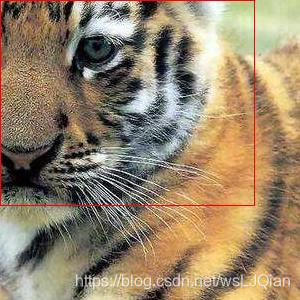
附录参考:
#######################CenterCrop###################################
import torch
import torchvision.transforms.functional as F
def crop(image, target, region):
cropped_image = F.crop(image, *region)
target = target.copy()
i, j, h, w = region
# should we do something wrt the original size?
target["size"] = torch.tensor([h, w])
fields = ["labels", "area", "iscrowd"]
if "boxes" in target:
boxes = target["boxes"]
max_size = torch.as_tensor([w, h], dtype=torch.float32)
cropped_boxes = boxes - torch.as_tensor([j, i, j, i])
cropped_boxes = torch.min(cropped_boxes.reshape(-1, 2, 2), max_size)
cropped_boxes = cropped_boxes.clamp(min=0)
area = (cropped_boxes[:, 1, :] - cropped_boxes[:, 0, :]).prod(dim=1)
target["boxes"] = cropped_boxes.reshape(-1, 4)
target["area"] = area
fields.append("boxes")
if "masks" in target:
# FIXME should we update the area here if there are no boxes?
target['masks'] = target['masks'][:, i:i + h, j:j + w] # masks截取这个区域作为新masks
fields.append("masks")
# remove elements for which the boxes or masks that have zero area
# 上面就crop修改完了,下面就是对修改后的结果,更新到coco数据库中
if "boxes" in target or "masks" in target:
# favor boxes selection when defining which elements to keep
# this is compatible with previous implementation
if "boxes" in target:
cropped_boxes = target['boxes'].reshape(-1, 2, 2)
keep = torch.all(cropped_boxes[:, 1, :] > cropped_boxes[:, 0, :], dim=1)
else:
keep = target['masks'].flatten(1).any(1)
for field in fields:
target[field] = target[field][keep]
return cropped_image, target
class CenterCrop(object):
def __init__(self, size):
self.size = size
def __call__(self, img, target):
image_width, image_height = img.size
crop_height, crop_width = self.size
crop_top = int(round((image_height - crop_height) / 2.))
crop_left = int(round((image_width - crop_width) / 2.))
return crop(img, target, (crop_top, crop_left, crop_height, crop_width))2.2 随机图像大小裁剪RandomSize_crop
########################RandomSize_crop############################
import math
import random
import torch
from PIL import Image, ImageDraw
import torchvision.transforms.functional as F
import torchvision.transforms as T
def RandomSize_crop(img, boxes, min_size: int, max_size: int):
"""
1.计算定位到裁剪的区域坐标top, left, height, width
2.img.crop裁剪图像
3.原boxes-裁剪区域box,去除掉超出边界的像素块
:param img: 原图
:param boxes: 原图boxes坐标
:param size: 随机裁剪的最小、最大尺寸
:return:
"""
w, h = img.size
w = random.randint(min_size, min(w, max_size))
h = random.randint(min_size, min(h, max_size))
print('w,h:', w, h)
# 使用torchvision.transforms.RandomCrop,获取随机尺寸
region = T.RandomCrop.get_params(img, [h, w])
i, j, oh, ow = region
print('i,j,h,w:', i,j,oh,ow)
img = img.crop((j, i, j+ow, i+oh)) #利用自带的图像处理,选取图像固定位置:top, left, height, width
print(img.size)
print('bo', boxes)
boxes = boxes - torch.Tensor([j,i,j,i]) #将boxes减去就可以需要的boxes位置信息
print('boxes', boxes) # (x1,y1,x2,y2)
print(boxes[:, ::2])
boxes[:, ::2].clamp_(min=0, max=ow-1) # clamp函数是用来防止超出边界, boxes[:, ::2]=tensor([[-154., 254.]])
print('bo1', boxes)
boxes[:, 1::2].clamp_(min=0, max=oh-1)
print('bo2', boxes)
return img, boxes
def draw(img, boxes, i):
draw = ImageDraw.Draw(img)
for box in boxes:
draw.rectangle(list(box), outline='red')
# img.show()
img.save('crop_'+str(i)+'.jpg')
def test():
img = Image.open('F:\lingjun2019\Body_Recog\Data-Augment-master\data\image/01.jpg')
boxes = torch.Tensor([[96, 34, 504, 355]])
# img_resized, boxes = resize(img, boxes, (300, 300))
# img_resized, boxes = center_crop(img, boxes, (300, 300))
for i in range(4):
img_resized, boxes = RandomSize_crop(img, boxes, 100, 350)
print(img_resized.size)
draw(img_resized, boxes, i)
if __name__=='__main__':
test()展示结果:
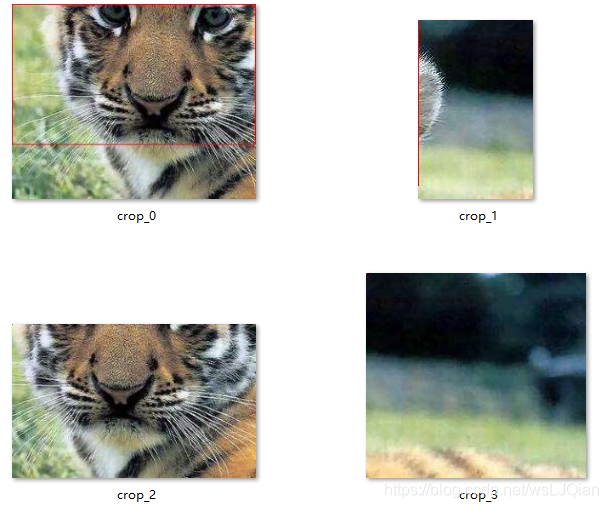
附录参考:
# T.RandomSizeCrop(384, 600),
class RandomSizeCrop(object):
def __init__(self, min_size: int, max_size: int):
self.min_size = min_size
self.max_size = max_size
def __call__(self, img: PIL.Image.Image, target: dict):
w = random.randint(self.min_size, min(img.width, self.max_size))
h = random.randint(self.min_size, min(img.height, self.max_size))
region = T.RandomCrop.get_params(img, [h, w])
return crop(img, target, region)2.3 随机裁剪Random_crop
def Random_crop(img, boxes, size):
"""
1.计算定位到裁剪的区域坐标top, left, height, width
2.img.crop裁剪图像
3.原boxes-裁剪区域box,去除掉超出边界的像素块
:param img: 原图
:param boxes: 原图boxes坐标
:param size: 固定大小裁剪的size
:return:
"""
w, h = img.size
print('w,h:', w, h)
# 使用torchvision.transforms.RandomCrop,获取随机尺寸
region = T.RandomCrop.get_params(img, size)
i, j, oh, ow = region
print('i,j,h,w:', i,j,oh,ow)
img = img.crop((j, i, j+ow, i+oh)) #利用自带的图像处理,选取图像固定位置:top, left, height, width
print(img.size)
print('bo', boxes)
boxes = boxes - torch.Tensor([j,i,j,i]) #将boxes减去就可以需要的boxes位置信息
print('boxes', boxes) # (x1,y1,x2,y2)
print(boxes[:, ::2])
boxes[:, ::2].clamp_(min=0, max=ow-1) # clamp函数是用来防止超出边界, boxes[:, ::2]=tensor([[-154., 254.]])
print('bo1', boxes)
boxes[:, 1::2].clamp_(min=0, max=oh-1)
print('bo2', boxes)
return img, boxes附录参考:
class RandomCrop(object):
def __init__(self, size):
self.size = size
def __call__(self, img, target):
region = T.RandomCrop.get_params(img, self.size)
return crop(img, target, region)三、随机翻转random_flip
import math
import random
import torch
from PIL import Image, ImageDraw
import torchvision.transforms.functional as F
def random_flip(img, boxes):
if random.random() < 0.5:
# transpose有这么几种模式FLIP_LEFT_RIGHT ,FLIP_TOP_BOTTOM ,ROTATE_90 ,
# ROTATE_180 ,ROTATE_270,TRANSPOSE ,TRANSVERSE
img = img.transpose(Image.FLIP_LEFT_RIGHT) #0.5的概率随机翻转
w = img.width
# method 1
print(boxes, boxes[:, 2])
# boxes[:, 2] 取所有行,取第3列
xmin = w - boxes[:, 2] #计算左顶角的位置 高的位置都不变
xmax = w - boxes[:, 0] #计算右低角的位置
boxes[:, 0] = xmin
boxes[:, 2] = xmax
# method 2
# boxes = boxes[:, [2, 1, 0, 3]] * torch.as_tensor([-1, 1, -1, 1]) + torch.as_tensor([w, 0, w, 0])
return img, boxes
def draw(img, boxes):
draw = ImageDraw.Draw(img)
for box in boxes:
draw.rectangle(list(box), outline='red')
img.show()
img.save('flip.jpg')
def test():
img = Image.open('F:\lingjun2019\Body_Recog\Data-Augment-master\data\image/01.jpg')
boxes = torch.Tensor([[96, 34, 504, 355]])
img_resized, boxes = random_flip(img, boxes)
print(img_resized.size)
draw(img_resized, boxes)
if __name__=='__main__':
test()
展示结果:
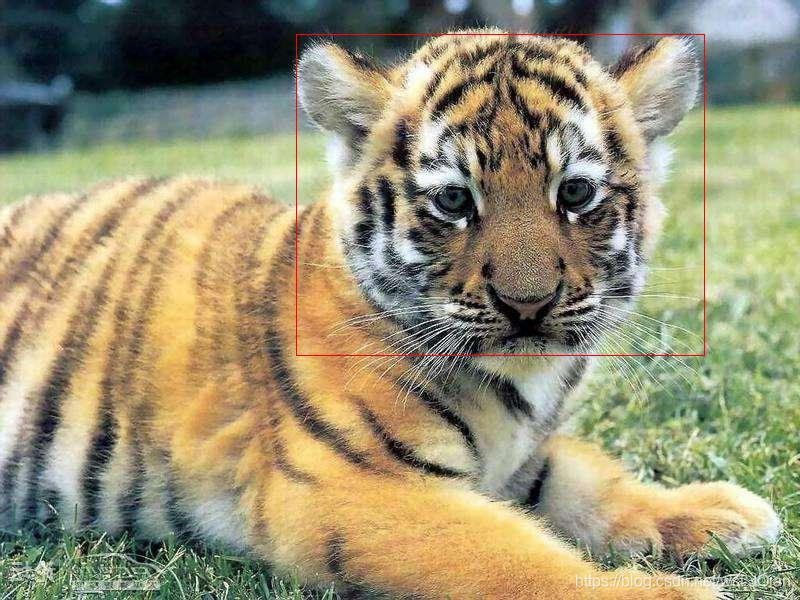
附录参考:
##################RandomHorizontalFlip#####################
def hflip(image, target):
flipped_image = F.hflip(image)
w, h = image.size
target = target.copy()
if "boxes" in target:
boxes = target["boxes"]
boxes = boxes[:, [2, 1, 0, 3]] * torch.as_tensor([-1, 1, -1, 1]) + torch.as_tensor([w, 0, w, 0])
target["boxes"] = boxes
if "masks" in target:
target['masks'] = target['masks'].flip(-1)
return flipped_image, target
class RandomHorizontalFlip(object):
def __init__(self, p=0.5):
self.p = p
def __call__(self, img, target):
if random.random() < self.p:
return hflip(img, target)
return img, target说明几点:
1.target['masks'] = target['masks'].flip(-1),意思是直接按列,水平对调
2.boxes[:, [2, 1, 0, 3]],所有行,按列调换
In [15]: c
Out[15]:
tensor([[1, 2, 3],
[4, 5, 6],
[7, 8, 9]], dtype=torch.int32)
In [16]: d=c.flip(-1)
In [17]: d
Out[17]:
tensor([[3, 2, 1],
[6, 5, 4],
[9, 8, 7]], dtype=torch.int32)
In [18]: d=c.flip(0)
In [19]: d
Out[19]:
tensor([[7, 8, 9],
[4, 5, 6],
[1, 2, 3]], dtype=torch.int32)
In [20]: d=c.flip(1)
In [21]: d
Out[21]:
tensor([[3, 2, 1],
[6, 5, 4],
[9, 8, 7]], dtype=torch.int32)
In [22]: f=c[:,[0,1,2]]
In [23]: f
Out[23]:
tensor([[1, 2, 3],
[4, 5, 6],
[7, 8, 9]], dtype=torch.int32)
In [24]: c
Out[24]:
tensor([[1, 2, 3],
[4, 5, 6],
[7, 8, 9]], dtype=torch.int32)
In [25]: f1=c[:,[1,0,2]]
In [26]: f1
Out[26]:
tensor([[2, 1, 3],
[5, 4, 6],
[8, 7, 9]], dtype=torch.int32)四、随机旋转Rotation
import math
import random
import torch
from PIL import Image, ImageDraw
import cv2
import numpy as np
import torchvision.transforms.functional as F
def create_rotation_matrix(angle, center, image_center, bound_w, bound_h, expand, offset=0):
center = (center[0] + offset, center[1] + offset)
rm = cv2.getRotationMatrix2D(tuple(center), angle, 1)
if expand:
# Find the coordinates of the center of rotation in the new image
# The only point for which we know the future coordinates is the center of the image
rot_im_center = cv2.transform(image_center[None, None, :] + offset, rm)[0, 0, :]
new_center = np.array([bound_w / 2, bound_h / 2]) + offset - rot_im_center
# shift the rotation center to the new coordinates
rm[:, 2] += new_center
return rm
def Rotation(img, boxes, angle, expand=True, center=None, interp=None):
w, h = img.size #(800, 600)
print('wwww',w)
print('hhhh',h)
img = np.asarray(img)
if len(img) == 0 or angle % 360 == 0:
return img, boxes
image_center = np.array((w / 2, h / 2))
if center is None:
center = image_center
if interp is None:
interp = cv2.INTER_LINEAR
abs_cos, abs_sin = (abs(np.cos(np.deg2rad(angle))), abs(np.sin(np.deg2rad(angle))))
if expand:
# find the new width and height bounds
bound_w, bound_h = np.rint(
[h * abs_sin + w * abs_cos, h * abs_cos + w * abs_sin]
).astype(int)
else:
bound_w, bound_h = w, h
rm_coords = create_rotation_matrix(angle, center, image_center, bound_w, bound_h, expand)
rm_image = create_rotation_matrix(angle, center, image_center, bound_w, bound_h, expand, offset=-0.5)
coords = np.asarray(boxes, dtype=float)
print('coords:', coords)
return cv2.warpAffine(img, rm_image, (bound_w, bound_h), flags=interp), cv2.transform(coords[:, np.newaxis, :], rm_coords)[:, 0, :]
def draw(img, boxes):
draw = ImageDraw.Draw(img)
for box in boxes:
draw.rectangle(list(box), outline='red')
# img.show()
img.save('rotate_180.jpg')
def test():
img = Image.open('F:\Data-Augment-master\data\image/01.jpg')
boxes = [[96, 34], [504, 355]]
img_rotated, coor = Rotation(img, boxes, 180)
img_rotated = Image.fromarray(np.uint8(img_rotated))
print(coor.shape)
coor_list = []
print(coor)
for i in range(coor.shape[0]):
for j in range(coor.shape[1]):
coor_list.append(coor[i][j])
print(coor_list)
draw(img_rotated, torch.Tensor(coor_list).unsqueeze_(0))
# img_rotated.show()
if __name__=='__main__':
test()
展示结果:(目前发现90,180,270,360的旋转还挺好,其他数字的旋转不太行,待改进)
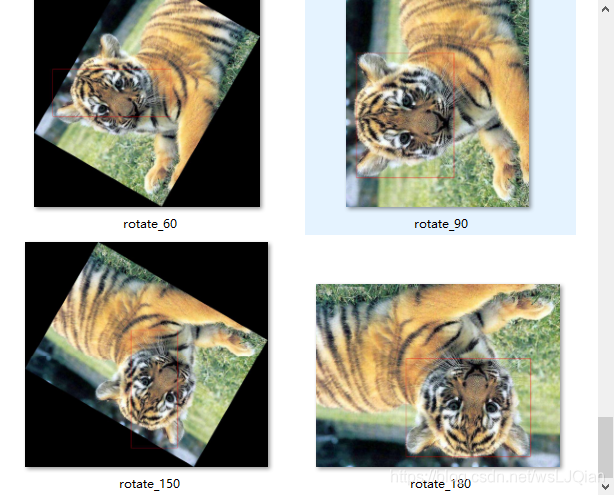
附录参考:
class RotationTransform(Transform):
"""
This method returns a copy of this image, rotated the given
number of degrees counter clockwise around its center.
"""
def __init__(self, h, w, angle, expand=True, center=None, interp=None):
"""
Args:
h, w (int): original image size
angle (float): degrees for rotation
expand (bool): choose if the image should be resized to fit the whole
rotated image (default), or simply cropped
center (tuple (width, height)): coordinates of the rotation center
if left to None, the center will be fit to the center of each image
center has no effect if expand=True because it only affects shifting
interp: cv2 interpolation method, default cv2.INTER_LINEAR
"""
super().__init__()
image_center = np.array((w / 2, h / 2))
if center is None:
center = image_center
if interp is None:
interp = cv2.INTER_LINEAR
abs_cos, abs_sin = (abs(np.cos(np.deg2rad(angle))), abs(np.sin(np.deg2rad(angle))))
if expand:
# find the new width and height bounds
bound_w, bound_h = np.rint(
[h * abs_sin + w * abs_cos, h * abs_cos + w * abs_sin]
).astype(int)
else:
bound_w, bound_h = w, h
self._set_attributes(locals())
self.rm_coords = self.create_rotation_matrix()
# Needed because of this problem https://github.com/opencv/opencv/issues/11784
self.rm_image = self.create_rotation_matrix(offset=-0.5)
def apply_image(self, img, interp=None):
"""
img should be a numpy array, formatted as Height * Width * Nchannels
"""
if len(img) == 0 or self.angle % 360 == 0:
return img
assert img.shape[:2] == (self.h, self.w)
interp = interp if interp is not None else self.interp
return cv2.warpAffine(img, self.rm_image, (self.bound_w, self.bound_h), flags=interp)
def apply_coords(self, coords):
"""
coords should be a N * 2 array-like, containing N couples of (x, y) points
"""
coords = np.asarray(coords, dtype=float)
if len(coords) == 0 or self.angle % 360 == 0:
return coords
return cv2.transform(coords[:, np.newaxis, :], self.rm_coords)[:, 0, :]
def apply_segmentation(self, segmentation):
segmentation = self.apply_image(segmentation, interp=cv2.INTER_NEAREST)
return segmentation
def create_rotation_matrix(self, offset=0):
center = (self.center[0] + offset, self.center[1] + offset)
rm = cv2.getRotationMatrix2D(tuple(center), self.angle, 1)
if self.expand:
# Find the coordinates of the center of rotation in the new image
# The only point for which we know the future coordinates is the center of the image
rot_im_center = cv2.transform(self.image_center[None, None, :] + offset, rm)[0, 0, :]
new_center = np.array([self.bound_w / 2, self.bound_h / 2]) + offset - rot_im_center
# shift the rotation center to the new coordinates
rm[:, 2] += new_center
return rm
def inverse(self):
"""
The inverse is to rotate it back with expand, and crop to get the original shape.
"""
if not self.expand: # Not possible to inverse if a part of the image is lost
raise NotImplementedError()
rotation = RotationTransform(
self.bound_h, self.bound_w, -self.angle, True, None, self.interp
)
crop = CropTransform(
(rotation.bound_w - self.w) // 2, (rotation.bound_h - self.h) // 2, self.w, self.h
)
return TransformList([rotation, crop])
五、总结:具体使用
上述都是一个个具体的增强模型,究竟具体到加入数据变换里面,可以参考下面的案例。仅做参考哦
def __getitem__(self, idx):
boxes = self.boxes[idx].clone()
labels = self.labels[idx]
size = self.input_size
# Data augmentation.
if self.train:
img, boxes = random_flip(img, boxes)
img, boxes = random_crop(img, boxes)
img, boxes = resize(img, boxes, (size,size))
else:
img, boxes = resize(img, boxes, size)
img, boxes = center_crop(img, boxes, (size,size))
img = self.transform(img)
return img, boxes, labels
最后,如果您觉得本篇文章对你有帮助,欢迎点赞,让更多人看到,这是对我继续写下去的鼓励。如果能再点击下方的红包打赏,给博主来一杯咖啡,那就太好了。





 本文深入探讨了深度学习中用于图像和目标检测的数据增强技术,包括等比例缩放、中心裁剪、随机大小裁剪和随机翻转。通过这些方法,可以增加模型的泛化能力,防止过拟合。文中还提供了详细的代码示例,如resize函数考虑了保持图像比例并限制最大尺寸,center_crop函数用于中心裁剪,RandomSize_crop实现了随机大小裁剪,random_flip函数则实现了随机水平翻转。此外,还介绍了旋转操作,包括旋转矩阵的创建和应用。这些技术对于构建高性能的深度学习模型至关重要。
本文深入探讨了深度学习中用于图像和目标检测的数据增强技术,包括等比例缩放、中心裁剪、随机大小裁剪和随机翻转。通过这些方法,可以增加模型的泛化能力,防止过拟合。文中还提供了详细的代码示例,如resize函数考虑了保持图像比例并限制最大尺寸,center_crop函数用于中心裁剪,RandomSize_crop实现了随机大小裁剪,random_flip函数则实现了随机水平翻转。此外,还介绍了旋转操作,包括旋转矩阵的创建和应用。这些技术对于构建高性能的深度学习模型至关重要。



















 2069
2069

 被折叠的 条评论
为什么被折叠?
被折叠的 条评论
为什么被折叠?










